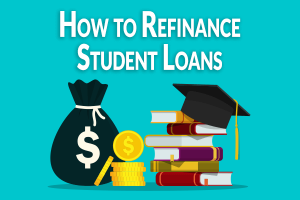Student loans are a common means of financing higher education, but the debt burden they create can be overwhelming for many borrowers. Student loan refinancing offers a potential solution to this problem, allowing individuals to secure more favourable loan terms and interest rates. In this article, we will delve into the intricacies of student loan refinancing rates to help borrowers make informed decisions about their financial future.

What is Student Loan Refinancing?
Student loan refinancing is a process in which borrowers take out a new loan to pay off their existing student loans. The new loan usually comes with different terms, which can include a lower interest rate, extended loan term, or both. The goal is to reduce monthly payments and save money over the life of the loan.
Understanding Student Loan Refinancing Rates
- Fixed vs. Variable Rates
When you refinance your student loans, you will have the option to choose between fixed and variable interest rates.
- Fixed Rates: A fixed rate remains the same throughout the life of the loan. This means that your interest rate and monthly payments are predictable and won’t change with market fluctuations. Fixed rates provide stability and are generally preferred for long-term financial planning.
- Variable Rates: Variable interest rates can fluctuate over time based on market conditions. They often start lower than fixed rates, but they can increase or decrease periodically. Borrowers who opt for variable rates take on some level of risk, as their payments can rise if interest rates go up.
- Creditworthiness Matters
Your credit score is a significant factor that determines the interest rate you will be offered when refinancing your student loans. Lenders use your credit score to assess your creditworthiness and the risk of lending to you. A higher credit score typically results in a lower interest rate, while a lower score may result in a higher rate. It’s essential to maintain a good credit score by paying bills on time and managing your finances responsibly.
- Loan Term
The length of your loan term, i.e., how long you have to repay your loan, can also affect the interest rate. Shorter loan terms typically come with lower interest rates, but higher monthly payments. Longer loan terms may have slightly higher interest rates but offer lower monthly payments. It’s crucial to strike a balance between an affordable monthly payment and minimizing the total cost of your loan.
- Private vs. Federal Loans
When refinancing, you can choose to consolidate both federal and private student loans into a single, new private loan. However, it’s important to note that refinancing federal loans with a private lender means forfeiting federal benefits like income-driven repayment plans, loan forgiveness options, and deferment or forbearance. Before refinancing, carefully weigh the pros and cons of consolidating federal loans into a private loan.
- Lender Selection
There are numerous lenders in the student loan refinancing market, each offering their own rates, terms, and benefits. It’s essential to shop around and compare offers from various lenders to find the most favorable terms. Factors to consider when choosing a lender include interest rates, customer service, and repayment flexibility.
- Co-Signer Options
If you have a limited credit history or a low credit score, some lenders may allow you to apply with a co-signer. A co-signer with a strong credit history can help you secure a lower interest rate. However, co-signers are equally responsible for the debt, and their credit can be affected if you miss payments.
- Loan Amount and Debt-to-Income Ratio
The total amount of your student loan debt and your debt-to-income ratio (the ratio of your monthly debt payments to your monthly income) can also influence the interest rate you receive. Lenders may offer more competitive rates to borrowers with lower debt amounts and lower debt-to-income ratios.
Benefits of Student Loan Refinancing
- Lower Monthly Payments: Refinancing can lead to lower monthly payments, making it easier to manage your finances.
- Interest Savings: A lower interest rate can lead to significant long-term savings on your loan.
- Simplified Payments: Combining multiple loans into one can simplify your monthly payments.
- Faster Debt Repayment: Shortening your loan term can help you pay off your debt faster.
Conclusion
Student loan refinancing rates play a critical role in the overall cost of your education debt. By understanding the factors that influence these rates and carefully considering your financial goals, you can make informed decisions about refinancing your student loans. While refinancing can offer significant benefits, it’s crucial to weigh the advantages against potential downsides, such as the loss of federal loan benefits. Ultimately, student loan refinancing can be a valuable tool to help you take control of your student loan debt and work toward a more financially secure future.